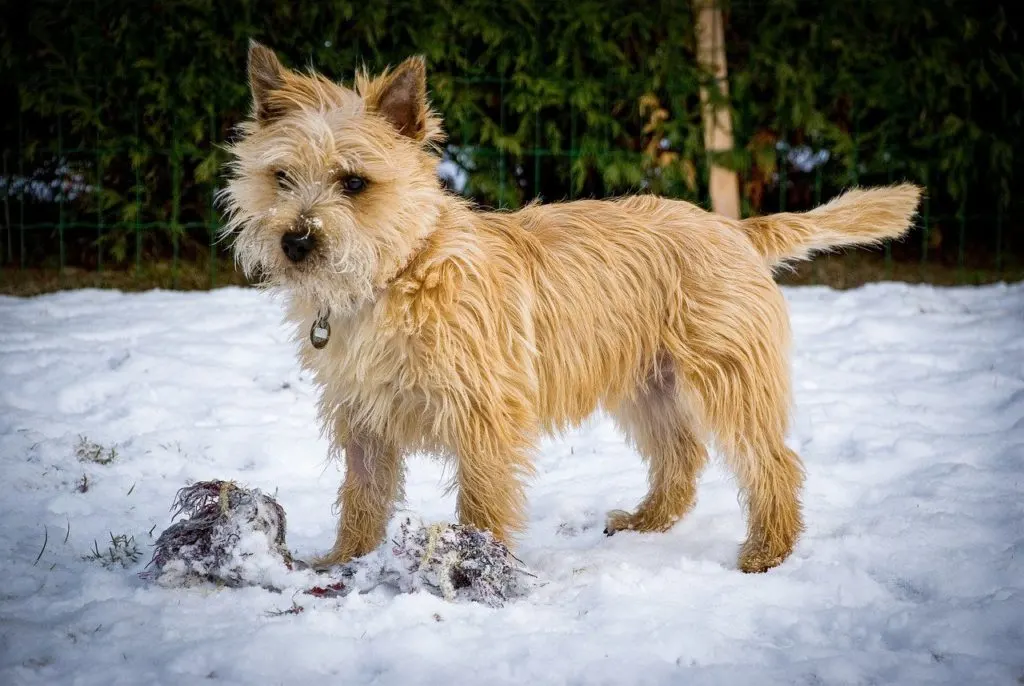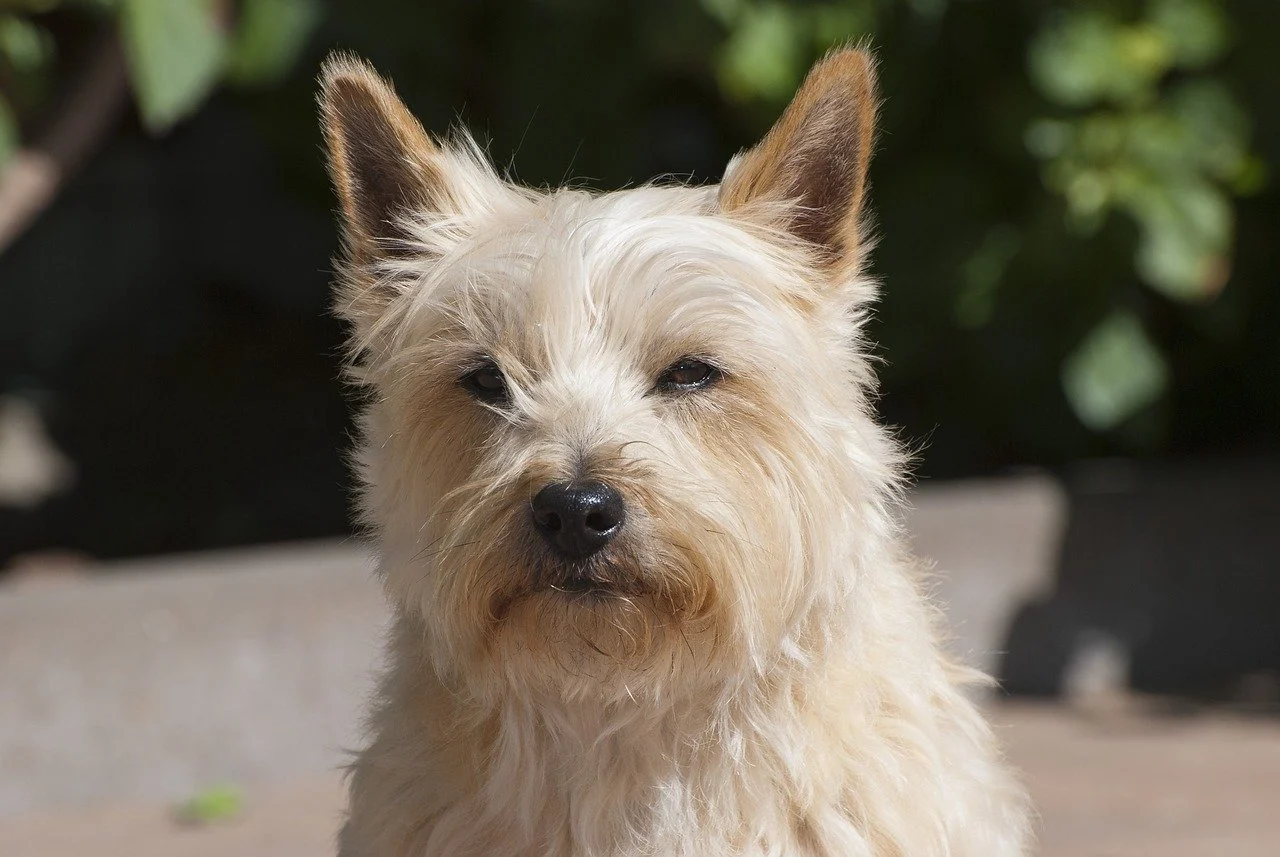Despite being small the Cairn Terrier will amaze you with its strength and endurance. The Cairn Terrier is a purebred dog that is recognized by the American Kennel Club as well as the American Canine Registry. This breed is a small working terrier that originated on the Scottish Isle of Skye.
Farmers utilized them to cleanse their land of vermin, and because they needed a dog with courage, persistence, and intelligence. All of the qualities that the Cairn possessed and possesses even today! Their history of patrolling farms of Scotland and Scottish highlands has granted the present-day Cairn a brave demeanor.
There isn’t much this smart dog can’t figure out. A Cairn can learn an infinite amount of tricks and orders with appropriate training.
You should know that it could be pretty hard to keep a Cairn Terrier from doing what all Terrier breeds enjoy doing: chase and pursue (and a little bit dig and bark). If given the opportunity, the Cairn will run after any small animal, so squirrels, cats, rabbits, and even other dogs.
Cairn Terrier makes an excellent family pet. He’s an amusing and lively dog who enjoys playing with children, but he will also raise the alarm when strangers approach so be cautious.
In this article, we will learn more about this adorable dog, how to train him, what his temperament is, appearance, health, and so much more. So, keep on reading!
History of the Cairn
The Cairn Terrier is one of the most ancient terrier breeds. They got their start in the Scottish Highlands and on the Isle of Skye. Cairn Terriers were previously classified as a breed alongside the Scottish Terrier and the West Highland White Terrier. But, in the early 1900s, the three began to be bred individually, and individual breeds emerged. The primary function of the Cairn Terrier is that of a ratter.
Quick Facts: Toto, the dog from The Wizard of Oz was a female Cairn Terrier named Terry, owned by Carl Spitz, a dog trainer. But, this wasn´t Terry´s first film role, she had appeared in several movies before her famous role in The Wizard of Oz. She was also one of the most popular Cairns.
Farmers used them to trap and kill mice, squirrels, and other vermin. Until they were introduced to the United Kingdom’s dog show in 1909, the Cairn Terrier was known as the Short-haired Skye Terrier. Sky Terrier breeders were not pleased with the moniker, therefore the Cairn Terrier was chosen as a compromise.
The Cairn Terrier got his new name from his frequent fox and badger trapping in Scotland’s very common cairns (man-made mounds of stones used for marking locations). They’d get inside and bark at their prey until the farmer came to claim it.
The Cairn is one of several terrier breeds, some of which are still extant others have become extinct, that have patrolled Scotland’s game preserves and farms for centuries.
The personality of the Cairn Terrier
Cairn Terriers are intelligent, independent, and affectionate dogs who make excellent family pets. These dogs are compact and affectionate, and they do well in apartments and large households with both new and seasoned dog owners. They do, but they are also high energy and will need their humans to keep them busy by taking them on walks and playing with them. The Cairn Terrier is an extremely amiable breed of dog.
He’s upbeat and pleasant, and he appears to enjoy meeting new people. The Cairn presents everything a terrier should be: independent, fierce, and watchful. Digging, barking, and chasing are all high on his list of enjoyable pastimes, as they are for any dog of the breed. If given the opportunity, he will chase any little animal, including the neighbor’s cat. He’s also a good watchdog, alerting you to any visitors.
The Cairn is also inquisitive and fast to pick up new skills. And, like all terriers, he’s self-sufficient and a little headstrong. He must understand who is in authority, or he will assume control. Early socialization and obedience instruction are critical.
But don’t be fooled. The Cairn Terrier is a big softie and has plenty of love to give. He lives on the attention of his loved ones, and he is sad if he is left alone for long hours. If that happens he will probably get very bored, and as it usually is with bored dogs, he will turn to disruptive and destructive behavior such as barking, digging, or gnawing. So don’t get surprised if they chew on your furniture or ruin your new pair of shoes.
Temperament of dogs
Despite his independent personality, Cairn is a sensitive dog. His feelings are easily injured, and he does not take scolding or harsh punishments well. Kind, positive training is the most effective way to teach Cairn.
But, you should also know that a variety of factors influence temperament, including heredity, training, and socialization. Puppies with good temperaments are interested and playful, eager to approach and be held by people. Choose the puppy amid the pack, not the one who has behavior problems like tearing up his littermates or hiding in the corner.
Quick Facts: Wallis Simpson, the Duchess of Windsor, adored the breed, as did J Edgar Hoover, the first Director of the FBI.
The Cairn, like all dogs, requires early socialization — being exposed to a variety of people, sights, sounds, and experiences — when they are young. Socialization ensures that your Cairn puppy develops into a well-rounded dog.
Enrolling him in puppy kindergarten is a terrific place to start or any other type of training. Besides that, we recommend enrolling your Cairn Terrier in a regular intermediate or advanced level of obedience training, as well as continued agility classes with an obstacle course for dogs. Inviting guests over regularly, as well as taking him to busy parks, stores that accept dogs, and on strolls to meet neighbors, will help him improve his social abilities.
The appearance of the Cairn
Cairn terriers are only nine to ten inches in height, 15 inches long, and weigh about 13 or 14 pounds.
Because they are so small, they are also true escape artists, so you need to make sure that you have a fenced yard if you let them play alone. But even then, we wouldn´t suggest you let them play on their own, chances are they will find a way to escape.

They have a large skull wide head and tiny, upright ears. Their bodies are compact, their legs are short, and their tail is natural and carried high. His eyes are deep brown and inquisitive, and his face is sometimes described as “fox-like,” an amusing description is given that this tiny guy was initially bred to root out vermin—including foxes!—from Scottish rock piles.
Also read:
- Whippet Dog Breed: What You Should Know
- Blue German Shepherd: Basic Breed Info
- Belgian Sheepdog: From herding dog to family pet
- French Bulldog: Size, personality, and health
- Peekapoo: The not so popular designer dog
- Baby Chihuahua: How much do they really cost?
Breed colors
Cairn terriers have a double coat. That means they have a soft undercoat and a shaggy, water-resistant, and harsh outer coat that gives them a youthful appearance. When it comes to the coat colors, there are many varieties:
- pure black Cairns,
- crimson Cairns,
- brindled Cairns,
- cream Cairns,
- red Cairns,
- wheaten Cairns,
- silver Cairns.
When it comes to the care of every few months, Cairn Terriers require clipping and trimming. Purists may argue that terrier coats should never be cut since it softens the coat and makes it more prone to matting. They instead advise hand-stripping (each dead hair pulled out so a new one can grow in its place). However, stripping is extremely time-consuming and uncomfortable for the dog in my opinion. Many groomers will no longer do it. Clipping is fine for pet dogs.
Health and diet of the Cairn Terrier
Cairns are generally healthy, but they are susceptible to certain health issues, as are all breeds. Not all Cairns will get any or all of these ailments. But it’s vital to be aware of them if you’re thinking about getting one.
If you’re looking to buy a puppy, look for a reputable breeder who can show you health certifications for both of your puppy’s parents. Health clearances demonstrate that a dog has been tested and cleared of a certain condition. Please never buy from puppy mills or breeders with questionable breeding ethics and practices. The Cairn Terrier Club of America is a wonderful place to start when looking for breeders.
- Liver Shunt: a liver illness in which blood arteries bypass the liver, preventing it from functioning properly. It can cause urinary and renal issues. If dogs are diagnosed early enough, they can respond well to treatment and live a long and complete life.
- Eye problems: Cataracts, Progressive Retinal Atrophy (PRA), and Ocular Melanosis are common in Cairns. Prospective parents will be subjected to eye examinations by reputable breeders.
- Hip and elbow dysplasia: occurs when the joint does not grow properly, resulting in progressive mobility issues and pain.
Quick Tip: Do not enable this small dog to develop Small Dog Syndrome. It is a condition in which they assume they are the pack leader to humans.
Diet
You should feed a high-quality, balanced diet to your dog, just like you would to any other dog. Because Cairns are prone to obesity and gaining much weight fast, strict portion control is required. It´s also important to keep your pup active through playtime, and a daily walk.
It doesn´t have to be a long walk, the goal is just to keep them moving. They will also love a good romp in your yard. But any activity is better than no activity. Remember, if your dog is obese any start is a good start.

